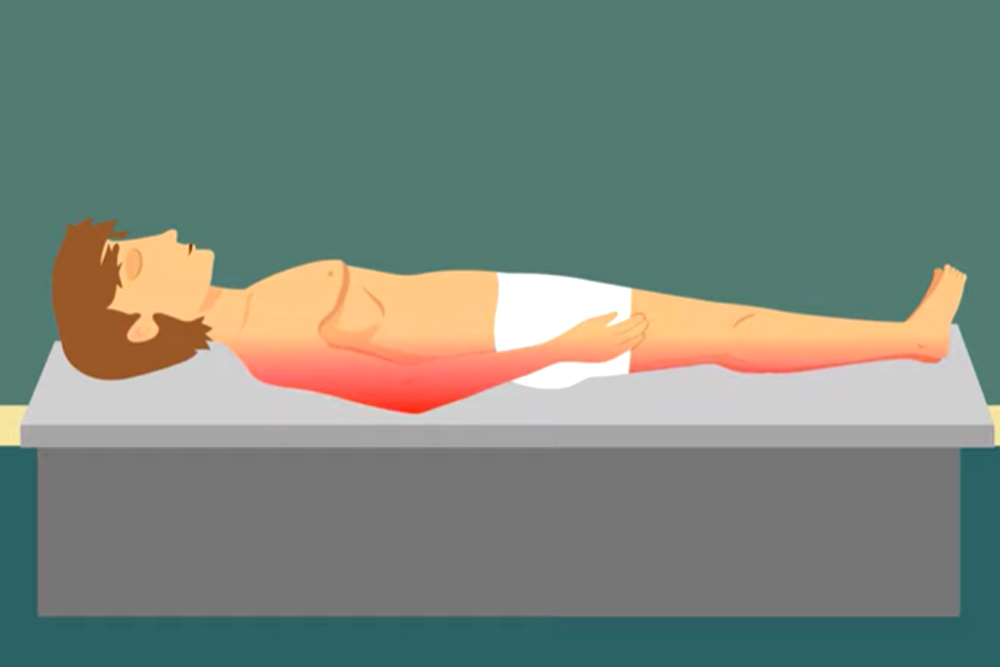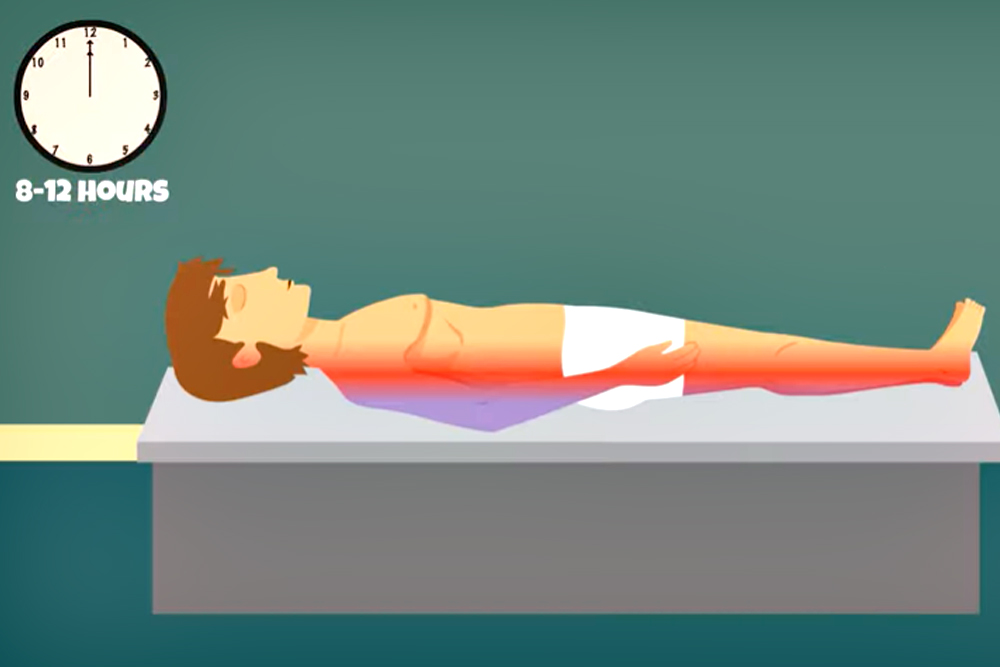Table of Contents (click to expand)
Livor mortis is the fourth postmortem sign of death. It is the development of a reddish-purple color to the skin due to the pooling of blood as a result of gravity.
Death has always fascinated and terrified mankind. We’ve written and documented countless texts and treatises on disease and death, all so we can understand what’s actually happening. What most people consider macabre and morbid has also enthralled philosophers, spiritual leaders, scientists and doctors.
There are a number of changes that happen to a body after death. These changes are the result of physical and chemical shifts happening to the body as it begins to decay. There are four discernible postmortem changes that occur in the first 24 to 72 hours after death: pallor mortis, algor mortis, rigor mortis, and livor mortis. This article focuses on livor mortis and how forensic experts use it to better estimate time of death.
What Is Livor Mortis?
Livor mortis is the fourth postmortem sign of death. It is the appearance of a reddish or purple discoloration of the skin. This lividity appears about 2 hours after death and becomes fixed (doesn’t fade once the corpse’s position is changed) after approximately 6 hours.
The earliest known description of livor mortis comes from 13th century China by Sung Tz’u, who wrote a comprehensive handbook on homicides and other deaths for forensic investigators of the time. In this book, he notes:
“Generally, dead persons have a slight red coloration on the back of the neck, on the top of the back, on the ribs, the back of the waist, the insides of the legs, the knees, the feet and the stomach. Check to determine if after death these corpses were laid out supine overnight. The collapse of the blood vessels may cause this slight red coloration, which does not indicate any other cause of death.”
Lividity will develop in the direction of gravity. Thus, if the corpse is lying horizontally on its back, then lividity will develop on the backside, where the pull of gravity is the strongest. If the corpse was in a sitting position, the blood will pool towards the thighs, lower back and buttocks.
Also Read: What Is Pallor Mortis?
Why Does Livor Mortis Happen?
The heart is constantly pumping blood throughout the body. It pumps an astounding 6,000-7,500 liters (1,500 to 2,000 gallons) of blood every day. It takes approximately 115,200 beats (80 beats per minute) for the heart to pump all the blood around to every part of the body. Without the heart, every organ—and every cell in those organs—would fail to receive the oxygen and nutrients that blood transports. Without the heart, all of this blood would fall under the influence of gravity.
This is what happens after death, once the heart stops beating. The blood in the blood vessels will begin to stagnate. The cells in the blood, such as the red blood cells (RBCs), white blood cells (WBCs) and platelets will begin to “sink” in the direction of the gravitational pull. This stagnation and settling of blood corpuscles leads to the development of livor mortis, but livor mortis would not develop without another physiological change.

Autolysis
After death, cells in the body begin to decay in a process called autolysis. Certain proteins, activated by the lack of oxygen and nutrients, begin to break down cellular components, including other proteins and DNA.
This process eventually leads to the breakdown of the cells that constitute the blood vessels. The blood contained within these vessels leaks out and pools between the layers of the skin, which leads to the development and fixing of livor mortis.
Deoxygenation Of Blood
There is a color change that happens after lividity has developed. Lividity in its initial stages is a red color, like that of normal blood, but over time, the color changes to a more purple hue because the RBCs become deoxygenated.
RBCs are the cells that collect oxygen from the lungs and transport it to the peripheral tissues for consumption. It is hemoglobin within the RBCs that actually holds the oxygen. The red color of blood (the bright red seen in arteries) is a result of oxygen binding to hemoglobin. When hemoglobin releases oxygen, this deoxyhemoglobin loses that bright red color and becomes a bluish-purple.
After death, tissues consume the existing oxygen held by hemoglobin. Once that pool of oxygen is depleted, the color of the blood will change from red to purple.
Also Read: What Are The 4 Postmortem Stages Of Death?
How Do Forensic Experts Use Livor Mortis To Calculate Time Of Death?
There are some visible changes that take place in a body after death. These changes are called postmortem signs of death and forensic experts use them to determine the time of death or post-mortem interval (PMI), if you want to use scientific jargon.
The appearance of lividity and the associated color change that occurs over time can tell forensic experts and pathologists a good deal about when the individual died. As mentioned earlier, lividity takes 2 hours to develop and 6 to 8 hours to become fixed, but these time stamps are dependent on certain external condition. Cooler temperatures slow the departure of oxygen from hemoglobin, which delays the color change.
Lividity also may not develop in those that are anemic. Depending on how advanced livor mortis is when investigators discover the body, forensic experts can usually estimate time of death.

Livor Mortis Can Give Clues In An Investigation
Livor mortis can also give clues about how an individual might have died, or what the body’s condition was soon after death. The development of lividity can be hindered in certain parts of the skin if there was an obstruction that blocked blood supply to that area.
This perturbed area of the skin will not have red or purple coloration and will instead have normal pale skin color. This is called contact blanching.
This can tell experts whether an individual was tied up using a rope or some other material, and provide information on what sort of surface the individual was laid on. If the body was laid on a hard surface, the area of skin that made contact with the surface would not have lividity as the hard surface would obstruct the blood vessels in that area.
It can also tell investigators if the body was moved after death, depending on how lividity developed.
There are different molecules that change the color of livor mortis. In carbon monoxide poisoning, lividity is a persistent cherry-red color. A similar color occurs due to cyanide poisoning.
Although livor mortis provides a lot of information to investigators about the nature of an individual’s death, it cannot be the only postmortem sign that coroners rely on. Investigators often use multiple clues, such as body temperature (algor mortis), stiffness of the muscles (rigor mortis) and insects near the area where the body was found (forensic entomology) to calculate PMI. Relying solely on a single postmortem sign would lead to inaccurate results.
How well do you understand the article above!

References (click to expand)
- Bisker, C., & Ralebitso-Senior, T. K. (2018). The Method Debate. Forensic Ecogenomics. Elsevier.
- Hayman, J., & Oxenham, M. (2016). Supravital Reactions in the Estimation of the Time Since Death (TSD). Human Body Decomposition. Elsevier.
- (2021) Postmortem Changes - StatPearls - NCBI Bookshelf. The National Center for Biotechnology Information
